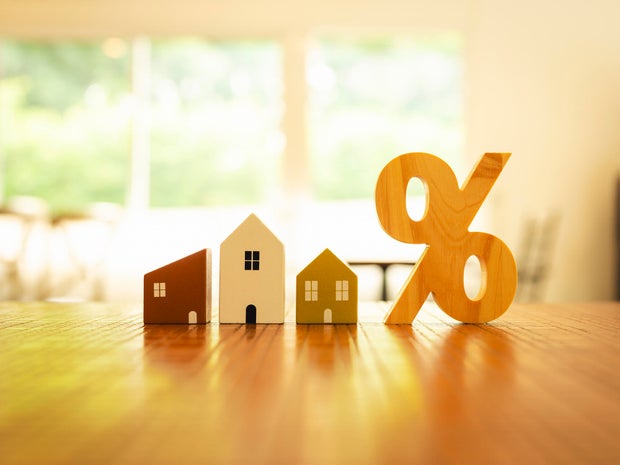 If certain conditions are met, home equity loan rates could decline this fall, experts say.
sommart/Getty Images
If certain conditions are met, home equity loan rates could decline this fall, experts say.
sommart/Getty Images
High interest rates have made it costly to borrow money in recent years. Credit card rates have soared, reaching an average of around 23% at one point, and personal loans haven't been great either, sitting at over 11% for all of 2025.
Fortunately, not all products have been affected as severely. In fact, home equity rates remain fairly affordable, with averages in the low- to mid-8% range, depending on the loan type and term you choose. Rates won't stay there forever, though, especially with a potential rate cut from the Federal Reserve on the horizon.
Are home equity loans still a good option if you need to borrow money this fall? And what can you expect to pay if you do get one? Below, we'll answer those questions and examine what the home equity loan rate forecast looks like for this fall.
Start by seeing what home equity loan rate you could qualify for here.
What's the home equity loan rate forecast for fall 2025?
The trajectory of rates on home equity loans and home equity lines of credit (HELOCs) is going to depend heavily on what the Federal Reserve does with the federal funds rate at its upcoming meetings.
"The most influential factor that will impact rates will be what happens to the federal funds rate," says John Jones, a certified financial planner at Heritage Financial. "Again, this is something hard to predict and can go either way, but ultimately will have a trickle-down effect on the yields and rates on many products and investments."
The federal funds rate directly determines what the prime rate is — and that's the basis for most HELOC rates. Rates on home equity loans are impacted by the Fed rate, too, though more indirectly. In general, rates on both products tend to follow the same trajectory as the Fed's moves.
"The Fed has the biggest influence," says Chuck Bowman, retail and business banking division manager at Amegy Bank. "Stay informed on when the Fed announces rate changes."
Compare your current offers to find the lowest rate online now.
Rates will likely fall — but only slightly
Fed Chair Jerome Powell indicated at a recent event that a Fed rate cut is likely on the horizon, and forecasts back that up. As of August 27, the CME Group's FedWatch tool shows about an 88% chance of a rate cut at the bank's September meeting.
"Heading into fall, I expect HELOC and home equity loan rates to begin coming down," says Evan Luchaco, home loan specialist at Churchill Mortgage. "We've heard more Fed members voicing opinions in favor of rate cuts, so I wouldn't be surprised to see this play out in real time."
Just be aware that the decrease in rates probably won't be extreme. In September, the Fed is expected to reduce rates by just 25 basis points.
"Don't expect fireworks," says Nicole Rueth, a mortgage executive and wealth builder at Movement Mortgage. "If inflation stays in check and the labor market breaks, it's likely the Fed will cut rates again, and we could see home equity rates inch down another 0.25% to 0.75% by year-end. However, if the Fed chooses to wait and see, rates will remain in their current range."
In short, she says, "Rates might dip slightly, but they're not coming down fast."
Watch the market conditions
The Fed's moves are the biggest driver of home equity rates, but what factors will drive the central bank's decisions? Rueth says inflation, the labor market, bond market sentiment, and "overall economic momentum" will all play into their decision.
"If the Fed sees signs that inflation is sticky or the job market remains resilient, they'll hold rates higher for longer, keeping the prime rate stuck in place," Rueth says. "But if unemployment ticks up or inflation softens, we should see the expected rate cuts."
In addition to these factors, you should also pay attention to your local housing market, says Mark Worthington, branch manager and home loan specialist at Churchill Mortgage.
"If we see a reduction in home values, it will also reduce the amount available for both HELOCS and home equity loans," Worthington says. It will also make these products riskier for lenders, which could make them harder to qualify for or even lead to higher rates to protect against this extra risk.
"Your local housing market matters," Bowman says. "When home prices stay strong in your area, it increases your borrowing capacity and lenders tend to be more competitive on rates."
The bottom line
Home equity rates will likely get lower in the coming months, but only by a bit. If you need an even lower rate — or don't want to wait for Fed rate cuts, there are other strategies you can use, too.
"Start with your credit," Rueth says. "The higher your score, the lower your rate. Aim for a 760-plus FICO, pay down credit cards, and hold off on opening new accounts before applying. Lenders are also rewarding lower loan-to-value ratios, so don't max out your equity, leave some cushion."
That last one is important, as the more equity you leave, the lower the risk is for the lender. You can also try and boost your equity by doing smart home improvements that increase your home value.
"If you're able, take action to increase the value of your home," Worthington says. "Curb appeal is very important, so if there are exterior improvements you can make that are impactful, those would be worth investing your time and money."
Finally, shop around for your lender, and don't be afraid to negotiate or ask about relationship pricing if you've used the bank or lender for other services. As Bowman explains, "Rates can differ by a full percentage point between lenders."
Aly J. Yale is a contributing writer for the Managing Your Money section for CBSNews.com, covering various personal finance topics, including investing, homebuying, loans and more.


















































